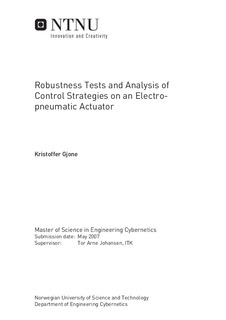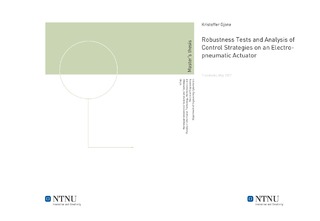| dc.contributor.advisor | Johansen, Tor Arne | nb_NO |
| dc.contributor.author | Gjone, Kristoffer | nb_NO |
| dc.date.accessioned | 2014-12-19T14:01:29Z | |
| dc.date.available | 2014-12-19T14:01:29Z | |
| dc.date.created | 2010-09-03 | nb_NO |
| dc.date.issued | 2007 | nb_NO |
| dc.identifier | 347456 | nb_NO |
| dc.identifier | ntnudaim:3310 | nb_NO |
| dc.identifier.uri | http://hdl.handle.net/11250/259604 | |
| dc.description.abstract | In this thesis a Sliding Mode Controller (SMC) is designed for an electro-pneumatic clutch actuator controlled by two on/off valves with PWM. The areas of application of the clutch actuator is in Automated Manual Transmission (AMT) and Clutch-by-wire (CBW) systems in heavy-duty trucks. As with most automated systems in the automation industry safety is the main priority, and in a cybernetic point of view this means that robustness of the control systems is very important. Sliding Mode Controllers are known for their excellent robustness properties and the focus of this thesis is to validate these properties for this particular application. The robustness properties of the SMC also indicates that a simple design model is adequate and since the existing mathematical models for this system are quite complex some simplifications are introduced. The controller design is performed in two phases. First an ideal SMC is designed, but since this introduces discontinuities in the control law any practical implementation would give heavy chattering at the output from the controller. Therefore a continuous linear approximation to the discontinuity is introduced. This controller is known as a boundary layer controller and it will reduce the control chattering to an acceptable level. The ideal controller is proven to be asymptotically stable, while for the boundary layer controller ultimate boundedness is achieved and a linearisation is performed for the case of a constant reference and this analysis shows that the origin of the linearised system is a stable focus. This indicates that the boundary layer controller might also be asymptotically stable. Since only a positionmeasurement is available to the control system the rest of the system states must be estimated. Velocity and acceleration are simply estimated as the first and second order filtered derivatives of the position measurement. The pressure is estimated based on the equation of motion for the clutch actuator. Through computer simulations and experimental testing the SMC has shown satisfying tracking performance and very good robustness with respect to parameter variations. Comparisons with a PD and a Backstepping controller shows that the performance of the SMC is superior to the PD controller and absolutely comparable to the Backstepping controller, though they have different strengths and weaknesses and therefore yield rather different results. | nb_NO |
| dc.language | eng | nb_NO |
| dc.publisher | Institutt for teknisk kybernetikk | nb_NO |
| dc.subject | ntnudaim | no_NO |
| dc.subject | SIE3 teknisk kybernetikk | no_NO |
| dc.subject | Reguleringsteknikk | no_NO |
| dc.title | Robustness Tests and Analysis of Control Strategies on an Electro-pneumatic Actuator | nb_NO |
| dc.type | Master thesis | nb_NO |
| dc.source.pagenumber | 85 | nb_NO |
| dc.contributor.department | Norges teknisk-naturvitenskapelige universitet, Fakultet for informasjonsteknologi, matematikk og elektroteknikk, Institutt for teknisk kybernetikk | nb_NO |

